TechRadar Verdict
There are two big compromises with this device. The first is cost, the second is weight.
Pros
- +
Windows 8 and Android
- +
Laptop, tablet or PC
- +
Lightweight tablet
Cons
- -
Chunky when docked
- -
Lackluster keyboard
- -
Dock bit fiddly
Why you can trust TechRadar
Apple CEO Tim Cook aimed a swipe at convertibles during the company's recent iPad Air and OS X 10.9 Mavericks launch. "Our competition is different," he said. "They're confused. They chased after netbooks. Now they're trying to make PCs into tablets and tablets into PCs. Who knows what they will do next?"
If any device sums up the industry's unpredictable nature, it's Asus' Transformer Book Trio. First unveiled at Computex, it's a multi-headed hydra of a convertible that lets you switch between Android Jelly Bean and Windows 8 at the push of a button.
As such it is a strange device. It's neither Ultrabook nor Android tablet. Instead, it's both - this is, to all intents and purposes, an Intel Core i5-toting Ultrabook that just so happens to be a convertible, with a detachable lid.
But rather than stick to Windows, detaching the touchscreen switches you immediately into Android 4.4.2. Likewise you can hot swap between the operating systems using a keyboard function key shortcut, so you can use the Trio's keyboard with Android, too.
Lenovo's IdeaPad U1 notebook gave a similar pitch back in 2010 but never made the leap into production. Samsung's Ativ Q, another Windows 8-slash-Android hybrid that was launched in London earlier this year, has been delayed due to patent problems - perhaps indefinitely. Will the Transformer Trio succeed where others have failed?

Software
Asus is billing the Transformer Book Trio as a "three-in-one" device thanks to its ability to function as an Android tablet on its own or as a Windows 8 (or Android) laptop when connected to its keyboard dock. As a third option, detach the tablet part of the device and the dock can act as a fully-fledged Windows 8 desktop PC on its own when connected to an external VGA or HDMI monitor.
This means you can use the tablet in Android mode at the same time as using the dock connected up to an external monitor in Windows 8 mode. Theoretically, at least, it opens up the doors to some nifty remote desktop-based action. Say you've got a meeting - for example - you could use the device as a laptop, detach the tablet, fire up TeamViewer or RealVNC and carry on viewing the contents on your external monitor on the Trio's PC Station.
One caveat of all of this is that the tablet can't be used in Windows 8 mode when detached as it automatically switches back to Android.
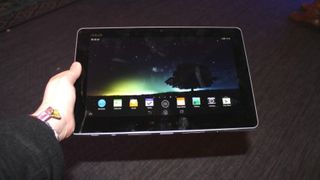
Switching between the two operating systems is as simple as pressing what Asus dubs the 'Trio' key, which is located on the top-right hand side of the keyboard. The actual switch is almost instant, taking around a second at the most. It holds a unique appeal if you can't be without your Android apps on a tablet and need the functionality of full-fat Windows 8.1.
Design and specs
The Trio sports a sharp 11.6-inch IPS display (1920 x 1080) that impresses with vibrant colours and deep blacks, which look particularly alluring when the tablet's running in Android mode.
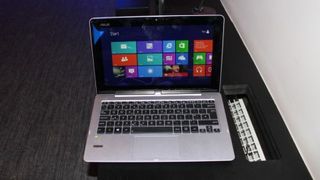
We were a little less enamoured with the black bezel surrounding the screen, which is a little too chunky for our tastes. It also picks up a fair few fingerprints, as would be expected on a reflective display of this type, but they were easy enough to wipe off.
As a tablet, the Transformer Book Trio is an 11.6-inch tablet that's powered by a dual-core Atom Z2560 CPU clocked at 1.6GHz. At 1.5lbs, it's light to hold, coming in fractionally heavier than Apple's iPad 2 (1.33lbs).
Unfortunately, that ultra level of portability stops in its tracks once the keyboard dock is attached, which isn't surprising as it houses the Trio's internal grunt. If you were to prise it open, you would discover a fourth-generation Intel Core i5 Haswell processor, a 64GB SSD, 4GB of RAM and a 500GB HDD.
Connecting the dock makes the device thicker and heavier, bulking up from 9.7mm at its thickest point to 13mm and going from 1.54lbs to 2.2lbs, putting it on a par with Apple's 11-inch MacBook Air (2.38lbs). It also converts it into a proper laptop.

Performance wise, we found that prodding around menus in Android was smooth and responsive with the tablet detached, though we're more excited about benchmarking the dock itself in Windows 8 mode to see how it'll fare when carrying out serious work hooked up to a large monitor.
Ports and features
The Transformer Book Trio offers a multitude of ports. The tablet part of the device contains a micro-USB port, a microSD card slot and an audio jack.
The docking station offers one mini DisplayPort, two USB 3.0 ports (one of which is a USB charger), one micro-HDMI 1.4 port with 1080p support and an audio jack.
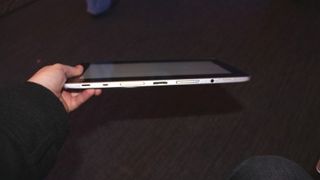
The Transformer Book Trio features a rear 5-megapixel snapper with auto-focus (which is still sadly lacking from Microsoft's Surface Pro 2) and 1080p full HD video recording. At the front is a 720p HD camera.
It can go for up to 13 hours on a single charge in Android mode, according to Asus, which lowers to five hours when used as a laptop in Windows mode. Other features include an accelerometer, ambient light sensor, gyroscope and e-compass.
Keyboard and dock
The Asus Transformer Book Trio's chiclet keyboard isn't the best or worst we've ever used, meaning it isn't likely to win any awards in this category. There's decent spacing between the keys themselves, but they lack travel and feel a little rigid to type on.
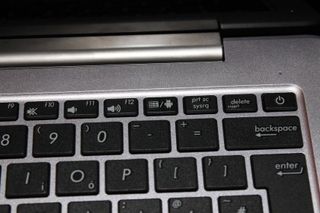
A button to switch between Windows 8 and Android is housed on the top right-hand side of the keyboard next to the F12 key. The tablet connects to the dock by means of a toothy clamp-style mechanism, which isn't as elegant as the magnetic connectors on Microsoft's Surface tablets, but it does provide a vice grip that leaves you confident they two won't seperate pressing the button to release them.
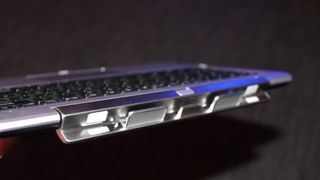
That said, we found that connecting the tablet to the dock with one hand was a fiddly affair, and one easier to undertake with the dock placed in the lap and the tablet inserted from the top (rather than trying to insert the dock into the tablet). It's perhaps something that would just take a bit of getting used to, and certainly wouldn't put us off the machine.
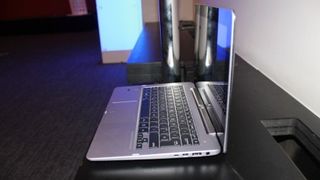
On first impresions, the Transformer Book Trio is at the same time a lightweight Android tablet and chunky hybrid device that could save you carrying around a separate Windows 8 device.
Verdict
There are two big compromises with this approach to a hybrid device. The first is cost. This is an expensive device and you may find yourself asking whether you'd be better off going to get a more standard Windows Ultrabook and topping that up with a reasonably priced Android tablet.
The second big compromise is in terms of weight. After all, there are two devices here, and while the whole laptop isn't exactly heavyweight, the fact remains that instead of a lightweight Ultrabook-style screen, you have a tablet with a pretty thick bezel there instead.

